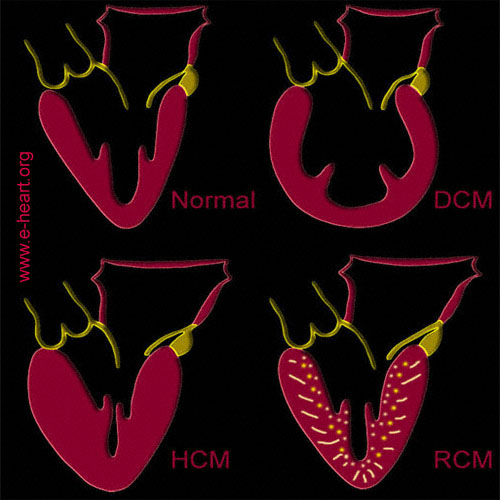Cardiomyopathies
Cardiomyopathy is a term that refers to the inability of the heart muscle to contract appropriately to meet the demands of the body . There are several types of cardiomyopathies defined by the World Health Organization. Dilated or cardiomyopathy (DCM), Hypertrophic cardiomyopathy (HCM), Restrictive cardiomyopathy (RCM), Arrhythmogenic right ventricular dysplasia / cardiomyopathy (ARVD/C), Ischemic cardiomyopathy (ICM) and cardiomyopathies due to or associated to specific systemic diseases.

Dilated cardiomyopathy is the most common type of cardiomyopathy, and also called congestive cardiomyopathy. In DCM, the heart is enlarged in size and its walls tend to be thin (thus the term dilated). The normal heart pumps blood throughout the body by contracting (pumping) and relaxing (to allow filling of its chambers) during the cycle of the cardiac beat. In DCM, the enlargement of the ventricles results in decreased performance in the “pumping” of blood during the cardiac contraction. Some of the causes for this dilatation and failure are known, such as viral infection producing myocarditis and affecting the cardiac muscle, mutations in genes that participate or regulate contraction of the heart muscle, hypersensitivity or toxic effects of drugs or other toxic chemicals , sometimes it occurs in association to pregnancy, but in the majority of patients (about 80%) the precise cause of the cardiomyopathy cannot be determined. It can affect individuals at any age, but the majority of patients diagnosed are middle age or young adults. Genetic diseases are beginning to be identified that seem to be the cause of DCM in some individuals and/or families.
Hypertrophic cardiomyopathy is characterized by marked thickening of the left ventricular wall, mainly the interventricular septum of the heart (i.e. the septum is the wall that divides the heart ventricles into left and right). This thickening is usually not due to high blood pressure and in most patients is asymmetric and can interfere with the normal propulsion of blood out of the heart, or in some patients the contraction of the cardiac wall is inadequate. In some patients, specific genetic defects have been identified that are responsible for the disease, and can be inherited.
Restrictive cardiomyopathy refers to an inability of the ventricles to stretch and fill with an adequate amount of blood during the relaxation period of the cardiac beat. Consequently the heart cannot pump enough blood out. In most cases restrictive cardiomyopathy is secondary to a systemic disease that affects the heart in advance stages. Disorders of iron metabolism or iron overload and other diseases that cause amyloid accumulation in the heart are the more common ones.
Arrhyrhmogenic Right Ventricular Dysplasia / Cardiomyopathy refers to a specific condition in which the right ventricular free wall myocardium is replaced by adipose tissue or the combination of adipose tissue and fibrosis. Arrhytmias, syncope and sudden death are common. Eventually, left ventricular failure can develop.
Ischemic cardiomyopathy is a term coined to identify a subset of patients with coronary artery disease, who develop heart failure with or without overt myocardial infarction or blockade of the large coronary arteries that feed the heart. Recently there has been a recomendation to abandon the use of this ambiguous term

